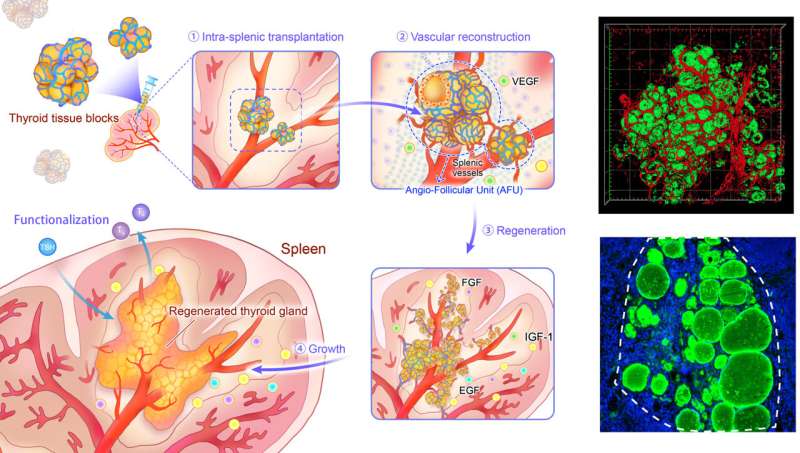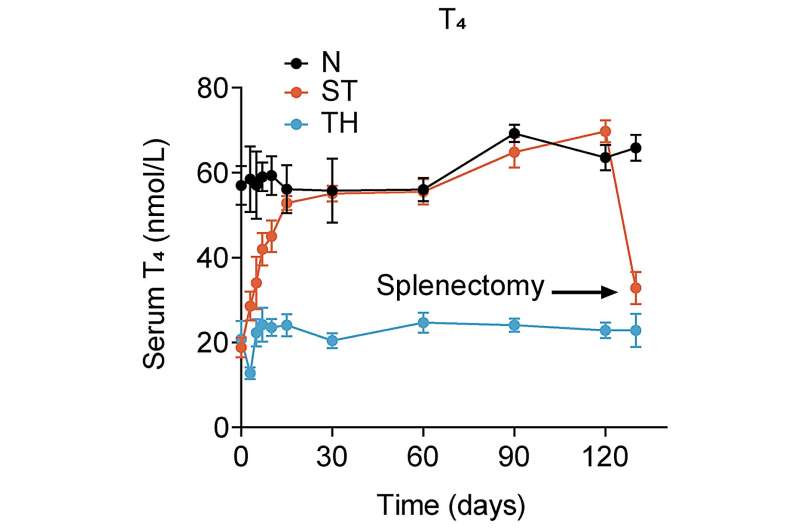This article has been reviewed according to Science X's editorial process and policies. Editors have highlighted the following attributes while ensuring the content's credibility:
fact-checked
peer-reviewed publication
proofread
Mouse study successfully regenerates thyroid glands in the spleen

Patients undergoing total thyroidectomy typically require lifelong oral levothyroxine sodium (L-T4) treatment. While effective in maintaining basic serum hormone levels, this treatment falls short in restoring the dynamic, responsive regulatory capacity of triiodothyronine (T3), essential for critical physiologic regulatory functions. Clinical data indicates that T3 deficiency can elevate the risk of hypertension, cardiac dysfunction, and other metabolic or mental health conditions.
Regenerative medicine involves the use of tissue engineering to create transplants of cells and tissues, potentially replacing the need for hormone replacement therapy. However, previous thyroid auto-transplantation experiments in animals and humans, targeting muscle or subcutaneous sites, have yielded unsatisfactory results. The efficiency of tissue or cell regeneration depends on various factors, including the condition of the transplanted tissue, the site, and the mode of transplantation.
In a recent study in Advanced Science, Dong's research team proposed an innovative solution to transplantation challenges by growing the thyroid in the spleen. Leveraging the spleen's unique properties, characterized by a loose structure and rich blood supply, the team explored a new strategy for thyroid regeneration. Intrasplenic thyroid transplantation was performed without compromising the structure and function of the spleen.
Mice with total thyroidectomy were transplanted with thyroid glands in the spleen, featuring intact follicles and reconstructed vascular networks. This approach successfully recapitulated the angio-follicular unit (AFU), leading to the complete restoration of hormone levels in mice.
Furthermore, studies have demonstrated that this method is more effective in responding to physiological signals than hormone replacement therapy. Moreover, long-term evaluation of the effects of hormone replacement therapy proved that the regenerated thyroid glands in the spleen completely restored the physiological homeostasis in the mice after total thyroidectomy without any adverse side effects, indicating significant potential for clinical applications.

Regenerating complex organs poses the most significant challenge in the realm of regenerative medicine. The primary obstacle hindering advancements in this field stems from the lack of effective methods to regenerate a fully developed, large-scale circulatory system within the bodies of adult animals.
This circulatory system is essential to support the regeneration of targeted organs. Addressing this challenge, Professor Dong Lei and his collaborators have recently proposed an innovative approach.
They leverage the unique structural features of the spleen—such as its abundant blood supply, loose internal structure, and capacity to accommodate a substantial number of implanted cells and tissues—as a regenerative platform for the ectopic regeneration of intricate tissue organs within the body.
Over the past few years, they have developed a series of technical approaches to modify the spleen's structure in live animals, aligning it with the regenerative requirements of target tissues and organs. Notable achievements in their earlier research involve the successful regeneration of the liver within the spleen.
The concept of regenerating one organ within another introduces the prospect of forging a novel technological pathway for regenerating large and complex organs distinct from conventional methods. This innovative approach holds the potential to drive significant breakthroughs in the field of regenerative medicine.
More information: Xue‐Jiao Tian et al, Regeneration of Thyroid Glands in the Spleen Restores Homeostasis in Thyroidectomy Mice, Advanced Science (2023). DOI: 10.1002/advs.202305913




















